Cabonga Trip, July 2019
by Mark German
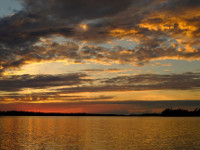
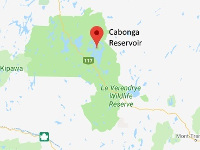
I found Tim's marketing for the Cabonga reservoir
quite compelling: a short drive away, endless sandy
beaches, island archipelagos, large bodies of fresh water, bikini-clad women, free margaritas... Wait, I
might be imagining those last two items. After hearing the sales pitch several times I asked if I might
do a trip up with him so I could experience this natural wonder in person. Lingering ice and snow
meant postponing our Victoria weekend plan to late summer, but got I a nice surprise in early July
when he invited me on a 4-day trip with his friend Dave.
Meeting in Portage du Fort we drove several hours to Le Domaine, pausing briefly in Maniwaki to
sample burgers and fries (good!). Bureaucracy took the better part of an hour as we registered, bought
a map (crappy, bring a topo map), paid for parking and camp permits, the latter surprisingly including a
mandatory $2.50/day for insurance. For that you get a plastic tab with a phone number that you can't
call because there's no cell service. Yeah, ya gotta love Quebec. $60 poorer (my charge for a 4 day trip,
the others paid more) we headed to Lac Rapide to load and go.
I'll wager that it's been awhile since 2 sailboats made their way into the hinterland from the ramp at Lac
Rapide as it's used mostly by motor-boating fishermen. In fact, during our stay we didn't see one other
camping group... just an occasional fishing boat.
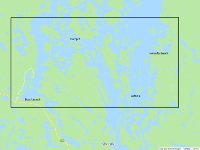
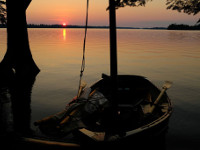
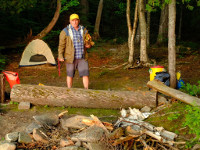 With a light wind on the nose we tacked down the lake, eventually bearing right through an unmarked
channel and a maze of islands, all looking remarkably alike. A great place to get lost if your nav skills
aren't up to date. With Tim and Dave sailing and me rowing, it took us an hour or two to traverse the
archipelago, emerging into a broad channel that seemed to stretch on forever. Down this we tacked
into a fitful wind, watching the rocky shores and forested islands slip by before reaching Camp 1
several hours later. Point to note... only one beach was seen, no bikini-clad women and definitely no
free margaritas!
With a light wind on the nose we tacked down the lake, eventually bearing right through an unmarked
channel and a maze of islands, all looking remarkably alike. A great place to get lost if your nav skills
aren't up to date. With Tim and Dave sailing and me rowing, it took us an hour or two to traverse the
archipelago, emerging into a broad channel that seemed to stretch on forever. Down this we tacked
into a fitful wind, watching the rocky shores and forested islands slip by before reaching Camp 1
several hours later. Point to note... only one beach was seen, no bikini-clad women and definitely no
free margaritas!
Perched on a hillside overlooking a tiny beach, Camp 1 boasted 4 camping sites, a toilet, a fireplace
and a gorgeous view down the channel we'd just traversed. In no time at all ice-cold beer was slaking
our thirst, a fire was crackling, the mosquitoes were whining and marinated lamb chops were grilling
under Tim's watchful eye. The warmth of the water was a warm welcome as I washed off the sweat,
quite unlike the frigid North Channel I'd sailed the week before. We washed down the lamb and corn-
on-the-cob with some Douro wine, then settled in to enjoy the sunset, sipping on single malt whisky,
swapping lies and watching the light fade into night.
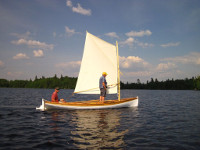
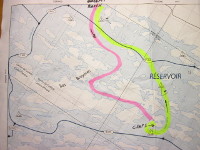
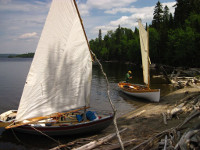 Day 2 dawned bright, sunny and still with just a few ripples stirred up by a meandering breeze. As our
caffeine levels rose and the corn, bacon and eggs cooked, the ripples grew into wavelets and our spirits
rose at the prospect of good sailing. Kicking around ideas we opted for another night at Camp 1 with a
daysail to the east and north where a large body of water promised some adventure. The wavelets
hadn't quite got themselves organized into waves so we took to the oars for an hour or so, tho Tim and
Dave quickly switched to sail and began catching up to me as I laboured along. By the time they joined
me I had my sail up too and we moved quickly with the wind behind us. Our goal was to reach a
beachy campsite we'd seen marked on the map, and although we found a beach it became clear that
we'd overshot the one we'd been trying to find. It's the nature of the area that makes navigation
challenging, requiring constant checking and re-checking of ones' position versus the map and a
compass or GPS would be a handy aid. The water was lovely with a glittering sandy bottom and piles
of driftwood made for handy seats while we ate lunch and contemplated the 20 km fetch that lay before
us. A north wind would have had this beach under water with 3-4 foot waves rolling in!!!
Day 2 dawned bright, sunny and still with just a few ripples stirred up by a meandering breeze. As our
caffeine levels rose and the corn, bacon and eggs cooked, the ripples grew into wavelets and our spirits
rose at the prospect of good sailing. Kicking around ideas we opted for another night at Camp 1 with a
daysail to the east and north where a large body of water promised some adventure. The wavelets
hadn't quite got themselves organized into waves so we took to the oars for an hour or so, tho Tim and
Dave quickly switched to sail and began catching up to me as I laboured along. By the time they joined
me I had my sail up too and we moved quickly with the wind behind us. Our goal was to reach a
beachy campsite we'd seen marked on the map, and although we found a beach it became clear that
we'd overshot the one we'd been trying to find. It's the nature of the area that makes navigation
challenging, requiring constant checking and re-checking of ones' position versus the map and a
compass or GPS would be a handy aid. The water was lovely with a glittering sandy bottom and piles
of driftwood made for handy seats while we ate lunch and contemplated the 20 km fetch that lay before
us. A north wind would have had this beach under water with 3-4 foot waves rolling in!!!
The next two hours saw us tacking back and forth across the channel to reach a smaller channel that
would eventually lead us through various islands and back to Camp 1. We'd no sooner entered its
shelter when we were caught by the edge of a squall that cost Tim his map collection, blown overboard
and unnoticed as the crew fought to control the boat. After that it was a hot windless slog at the oars for
a couple of hours to gain Camp 1 and a welcome swim. Tally for the day: 2 beaches, no women in
bikinis, no margaritas.
On the other hand, there was cold beer, followed by steaks and fried potatoes, so life was not so bad.
The weather, however, seemed to have decided that we were having way to much fun. Thunder rolled,
lightning flashed, the wind rose and Tim was re-arranging the mooring lines on his brand new whitehall
as the rising waves bounced it around. For about an hour we stood there dripping,watching the show
and just when it looked like it was going to be a rainy night the skies cleared. We celebrated by
finishing off the scotch and I turned in before dark, falling asleep pretty much instantly.
Scrambled eggs with bacon and turkish-style coffee got our 3rd day off to a terrific start as we broke
camp and established our plans. With a healthy north wind we began the long beat upwind, criss-
crossing each other's tack, sometimes with only a few feet to spare – it was an exciting, albeit wet ride
in the shellback dinghy. It was interesting to compare the performance of the two boats. The longer,
sleeker whitehall slid through the waves effortlessly while Phoobar tended to splash water all over the
place, particularly my face! I had to stop at times to pull on extra clothing to stay warm. After a couple
of hours of this Tim put to shore to fix his sailing rig and I followed about 10 minutes later. Not more
than 20 feet from shore a loud CRUNCH! heralded my arrival as my daggerboard contacted an unseen
rock, obscured by the reflecting sun. It was only when I reached shore and looked down that I noticed
3-4 inches of water in the bottom of my boat. I was sinking!
Hmmmmmmm..... DON'T PANIC!
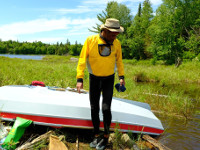
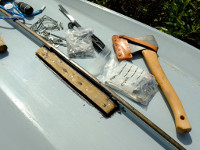
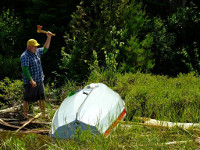 Unloading the boat it soon became clear that the daggerboard case had been literally ripped out of the
bottom of the boat at its aft end, creating an opening about 1/2 inch deep and several inches long.
Between Tim and I we had a fair amount of repair equipment and were able to saw a wooden patch
from my spare daggerboard to cover the slot in the hull (we had the boat over-turned by this point). Tim
had some really sticky black sealant so we smeared that liberally over the patch and around the
daggerboard slot before attaching the patch with some galvanized nails and stainless steel screws.
Unloading the boat it soon became clear that the daggerboard case had been literally ripped out of the
bottom of the boat at its aft end, creating an opening about 1/2 inch deep and several inches long.
Between Tim and I we had a fair amount of repair equipment and were able to saw a wooden patch
from my spare daggerboard to cover the slot in the hull (we had the boat over-turned by this point). Tim
had some really sticky black sealant so we smeared that liberally over the patch and around the
daggerboard slot before attaching the patch with some galvanized nails and stainless steel screws.
Now I was back in business, but with limited sailing ability as I had no more daggerboard; I could
manage a broad reach or a run, neither of which was going to work with the wind out of the north, so I
got out the oars and began pulling. We split up at that point, Tim and Dave staying in the open water
while I navigated a more protected (I hoped!) route through some islands. It wasn't protected at all in
the beginning and I had to use every trick in the book to progress to windward, especially when
rounding points, but after plugging away at it for 2 hours I'd worked my way into a sheltered area.
Now a different challenge presented itself: how to navigate the maze of islands to reach the campsite
we'd selected. I stopped the boat many times to scratch my head and try correlating what I was seeing
with what the map showed. A curious bald eagle dropped by to check me out, so I took that as a good
omen and carried on.
It must have been 2 hours later when I neared the place where the campsite was supposed to be and
rounded a point into the full blast of the wind. A quiet channel lay 1000 feet to windward and I was
pretty sure that was where I needed to go. I heard a noise but looking around I saw nothing. Turns out
it was one of the guys yelling at me! It felt like it took another 1/2 hour to make enough headway to
get close to the channel and then I saw Dave waving at me from the shore. What a relief!
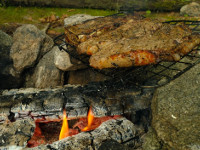
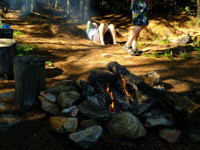
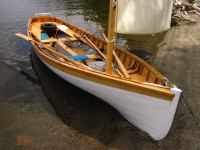 Camp 2 turned out to be fabulous, nestled in a grove of pines with a nice pine needle floor, lots of
airflow, plenty of shade, and a dappling of sunshine. A fire smouldered away to annoy the mosquitoes
and there was plenty of room to lie down and chill out. It even had two nice wooden benches that
doubled as cutting boards and side-tables. I think the guys were surprised to see me... they said they'd
been making bets as to when, or even if, I would arrive. Personally, I wasn't all that sure myself as to
when, or if, I would arrive, LOL.
Camp 2 turned out to be fabulous, nestled in a grove of pines with a nice pine needle floor, lots of
airflow, plenty of shade, and a dappling of sunshine. A fire smouldered away to annoy the mosquitoes
and there was plenty of room to lie down and chill out. It even had two nice wooden benches that
doubled as cutting boards and side-tables. I think the guys were surprised to see me... they said they'd
been making bets as to when, or even if, I would arrive. Personally, I wasn't all that sure myself as to
when, or if, I would arrive, LOL.
Did I mention the watermelon? OMG, was it ever good. Tim has this incredible knack for serving
delicious food, despite running his Volvo over one of the food bags at the launch (that put an end to the
onion bahji's and mango chutney he'd planned for dinner). I'd brought along some pre-cooked indian
food so we threw that together with some fried potatoes and had a spicy feast. The leftover melon got
slushed up and dumped into my rum, augmented with some of Dave's orange juice. Delicious! Bars of
70% Polish dark chocolate rounded out the meal.
Day 3's tally: no beaches, no free margaritas, no women, LOTs of islands.
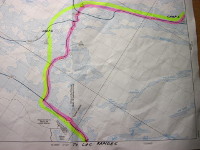
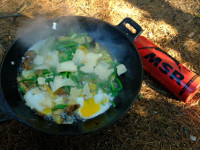 Day 4 was gorgeous: clear skies and light wind. Breakfast was outstanding: fried potatoes, garlic
scapes, eggs and parmesan cheese, with loads of coffee. What a great way to start the day! A short row
for me and a light sail for Tim and Dave got us back to Lac Rapide. With the wind behind me I hoisted
the sail and coasted back to the ramp, arriving 15 minutes or so after the faster whitehall. We stopped
in Gracefield for a Big Mo, one of the best burgers I've ever eaten. I splurged and got a small poutine
as well which did not disappoint.
Day 4 was gorgeous: clear skies and light wind. Breakfast was outstanding: fried potatoes, garlic
scapes, eggs and parmesan cheese, with loads of coffee. What a great way to start the day! A short row
for me and a light sail for Tim and Dave got us back to Lac Rapide. With the wind behind me I hoisted
the sail and coasted back to the ramp, arriving 15 minutes or so after the faster whitehall. We stopped
in Gracefield for a Big Mo, one of the best burgers I've ever eaten. I splurged and got a small poutine
as well which did not disappoint.
So all in all, I'd have to declare the trip a success, despite the damage to my boat. The food and drink
was fabulous, the company entertaining and the sailing outstanding. I highly recommend the area for
dinghy cruising to anyone who knows how to navigate and even then, one can stick to the big water
and avoid the intricate channels and islands that get so confusing.
Lessons Learned:
- Upgrade my repair kit to include gorilla tape, more screws and most importantly, sticky black sealant
- Bring a topo map
- Convert Phoobar from a daggerboard to a centerboard; a kickup rudder would be good too!
- Be careful about the Tim's marketing... not so many sandy beaches, tho they're probably mostly underwater
